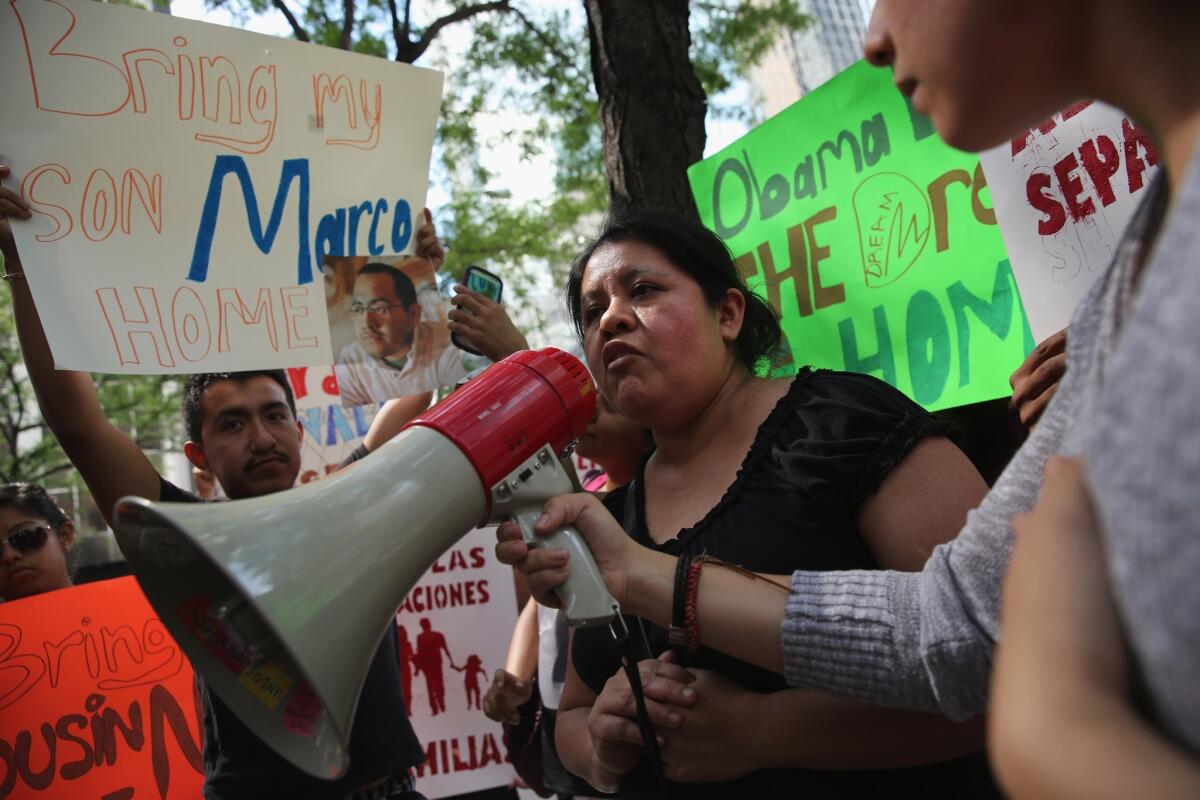Mexican nationals, the ‘Dream 9,’ take a step toward asylum

PHOENIX — Young immigrants known as the “Dream 9” will get the chance to argue their case for asylum before an immigration judge, potentially setting a precedent that would inspire other Mexican nationals to make similar claims for asylum in the U.S, immigration experts said Tuesday.
The five women and four men, who were brought to the U.S. illegally as children, staged an unconventional and risky protest last month at the U.S.-Mexico border to spotlight the thousands of people deported under the Obama administration.
When the so-called Dream 9 — named for the Dream Act, which would provide them a path to legalization — attempted to reenter the U.S. at the Nogales, Ariz., port of entry, they were arrested. They have been in federal custody ever since.
On Tuesday, immigration asylum officers found that all nine had credible fear of persecution or torture in their birth country and could therefore not be immediately removed, said Margo Cowan, the group’s attorney.
Their cases now go to an immigration judge, who will decide whether to grant asylum. If a judge does so, it would probably complicate matters for federal officials, said Carlos Spector, an immigration attorney in El Paso who is considered an expert in Mexican asylum claims.
“It opens up a political can of worms,” he said.
The development came the same day President Obama delivered a speech on housing and the economy in Phoenix. Outside the auditorium, a crowd of about 30 immigrant rights activists demanded release of the Dream 9, chanting, “Bring them home.”
As of Tuesday afternoon, all nine were still in custody at the Eloy Detention Center in central Arizona. However, it seemed they could be released within a day or two and allowed to return to their American communities with a notice to appear in immigration court, said Mohammad Abdollahi, an organizer with the National Immigrant Youth Alliance, which helped organize the protest. The cases will probably take years to litigate, Cowan said.
The protest took root in July when Marco Saavedra of New York, Lizbeth Mateo of Los Angeles and Lulu Martinez of Chicago — all young adults brought into the U.S. illegally as children — voluntarily crossed the border into Mexico as a protest of the administration’s deportation policies. They tried to reenter the U.S. on July 22 with six other dreamers who also had been brought to this country illegally as children but had returned to Mexico more than a year ago for various reasons.
Citizenship and Immigration Services officials said they would not discuss their cases because asylum applications were confidential under immigration law. The Obama administration has remained silent about the Dream 9.
Comparatively few Mexican nationals have been granted asylum, although applications have increased as drug violence skyrockets in some parts of Mexico.
A person seeking asylum must establish a well-founded fear of persecution based on “that he or she belongs to a race, religion, nationality, membership in a particular social group, or political opinion,” according to Citizenship and Immigration Services guidelines.
Some of the Dream 9 are petitioning for asylum, saying that they have family members who have been killed and face death threats themselves.
However, many in the Dream 9 claim they should be granted asylum because they belong to a particular group of people — that they are singled out and persecuted in Mexico because they have lived most of their lives in the U.S. They could become targets for criminal organizations that see them as easy prey for extortion and violence, they claim.
Winning asylum will be difficult, said Spector, adding that 98% of asylum claims made by Mexican nationals are denied. Still, he applauded the group, calling the nine “courageous” for pushing the legal envelope.
Ira Mehlman, a spokesman for the Federation for American Immigration Reform, a Washington-based group opposed to illegal immigration, criticized the Dream 9.
“Our asylum process is not there to create political theater,” he said.
The United States shouldn’t be responsible to opening its doors to people just because they come from countries with political upheaval, he said. If the group succeeds and stretches the definition of who can gain asylum, he said, it would open the floodgates to many across the world.
Matthew Kolken, an immigration attorney in New York who has fought asylum cases, said there had been a movement for federal officials to provide asylum for more Mexican nationals because of increased violence in the country.
But, he said, it’s not politically palpable. “Unfortunately, like everything else, politics comes into play. It’s basically saying that one of our largest trading partners is persecuting someone or can’t protect someone from being persecuted,” he said.
ALSO:
Quiz: Test your knowledge of Powerball
Military rules prevent hung jury in Ft. Hood shooting trial
Maj. Nidal Malik Hasan tells court-martial: ‘I am the shooter’
Twitter: @thecindycarcamo
More to Read
Start your day right
Sign up for Essential California for news, features and recommendations from the L.A. Times and beyond in your inbox six days a week.
You may occasionally receive promotional content from the Los Angeles Times.







